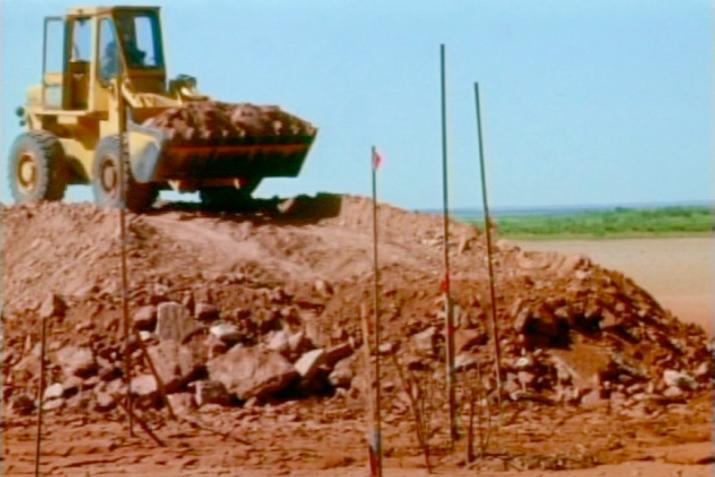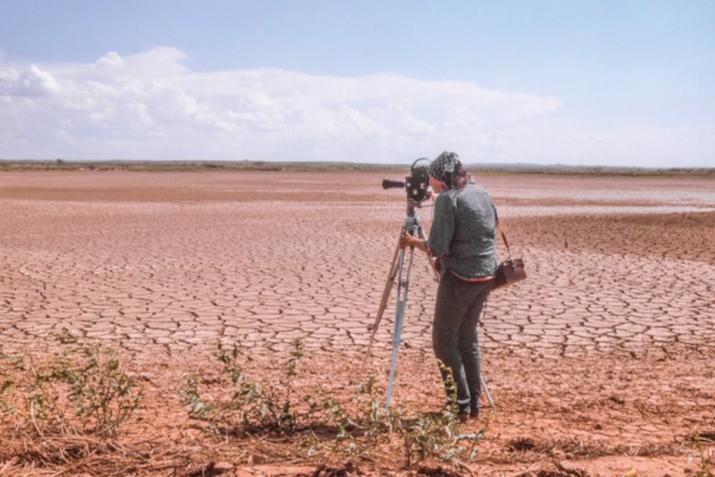Nancy Holt Interviews at Amarillo Ramp

Nancy Holt conducted interviews with two individuals that helped to create Robert Smithson's Amarillo Ramp shortly after its completion in 1973.
The first interview on the tape is with a yet-to-be-identified individual. During this conversation they share thoughts on the local climate and geography, and the effect the seasons will have on the artwork. In the second interview—featuring Sid Feck, whom Holt credits in The Making of Amarillo Ramp as the front loader operator—they discuss how it felt to drive the machinery out onto the end of the ramp, the color of the stone and process of selecting the stone, and the relationship of the work to "old mother earth." The interview with Sid Feck begins 17 minutes into the tape.
Amarillo Ramp is Smithson’s final earthwork; while surveying the site in 1973, Smithson was killed in a plane crash alongside pilot Gale Ray Rogers and photographer Richard I. Curtin. The sculpture was posthumously completed by Nancy Holt and artists Tony Shafrazi and Richard Serra, with help from a local team of heavy-machine operators who are featured in these interviews.
Download the full transcript at the bottom of the page.

Excerpt starting at 13 minutes 57 seconds:
UNIDENTIFIED SPEAKER: Oh, tell me this. Is it just...what's the purpose of it?
NANCY HOLT: Well, it's a sculpture. It's an earth sculpture.
US: Earth sculpture.
NH: And it's about calling attention to the things that already are here, you know. Like, those rocks are very beautiful, you know. And it's also about certain sculptural, like, mass, massiveness. It's about being able to walk out on it and having the landscape come around in a full panorama. Also, when you walk up to the top of it, you'll be able to look over into the valley here. And it's a new way of working, you know. It's doing a sculpture right in a particular place where you consider all the aspects of the place.
US: Yeah.
NH: And it's a new way.

Excerpt starting at 26 minutes 49 seconds:
SID FECK: This is my first job to finish, Nancy, where I had to do it going backwards.
NANCY HOLT: [CHUCKLES] Well, you got really good at it. I saw you—whipping around here.
SF: I tried to do the best I could for you, Nancy. That's what I tried to do.
NH: Right. Now you also ripped out some of the rocks here from the quarry place up there in the hill.
SF: Yes. I done that with a dozer, Nancy. And what I was trying to do is just find what rock that was suitable, you know, to make it look like something. You was telling me that you wanted a rock change on it, and that's the reason why I went up there with a dozer and ripped three or four different places, made three or four different stockpiles for you.
And then, as we brought it down here and stockpiled it—And then I switched to a little of this and a little of that to change the color for you as I placed them on there for you.
NH: Now, when you took the rock out of the earth, weren't they in certain, like, stratas or levels in the hill?
SF: Yes, there was layers of them, Nancy. And the farther down we went, the thicker they were. They started out little layers at the top that were a little different color. And then you go down two or three feet, and you get a different color. And as I ripped them, they just mixed up, you know. And then when we loaded them, well, we mixed them again.
NH: Yeah.
SF: That's the reason why we have a change of color, you know.
NH: Tony told me that, when you ride out on that, you felt you were going to nowhere. Is that right?
SF: Yeah. It seems like that, you know, really.
NH: How else could you describe that?
SF: Well, it's just like you're going to outer space. You're going up all the time and just come to one end there where you're—You know, you don't know where you go from there.
NH: Right, yeah. Well, that's a good way of saying that. I like that. Yeah.
Now, when you were driving up there in the front loader, did you ever look out and look at the landscape, the panorama of the landscape?
SF: Yes, I did, Nancy, but I still had to keep my eye on what I was doing.
NH: [CHUCKLES] Right.
SF: It was pretty narrow, you know.
